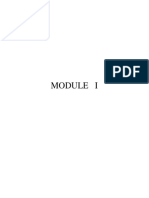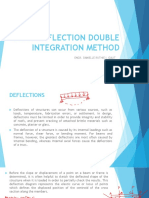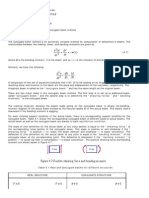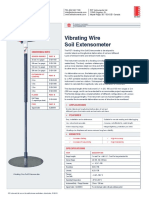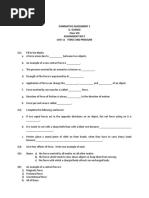Double Integration Method: Elastic Curve
Uploaded by
Caila PanerioDouble Integration Method: Elastic Curve
Uploaded by
Caila PanerioMODULE 4 A positive moment tends to bend a beam or
horizontal member concave upward.
DOUBLE INTEGRATION METHOD
Likewise, a negative moment tends to bend
If the deformation disappears and the the beam or member concave downward.
structure regains its original shape when the
actions causing the deformations are Therefore, if the shape of the moment
removed, the deformations are termed elastic diagram is known, it will be easy to construct
deformations. the elastic curve and vice-versa.
The permanent deformations of structures
are referred to as inelastic or plastic
deformations.
Elastic Curve
Before the slope or displacement of a point on
a beam or frame is determined.
It is often helpful to sketch the deflected
shape of the structure when it is loaded to
partially check the results.
This deflection diagram represents the elastic
curve or locus of points which defines the
displaced position of the centroid of sections
along with the members.
ELASTIC-BEAM THEORY Deflection of beams is so small, such that the slope
of the elastic curve dy/dx is very small and
If the material is homogeneous and behaves in a
squaring this expression, the value becomes
linear elastic manner, the Hooke's Law
practically negligible,
applies, ε = σ / E. Also, since the flexure formula
applies, σ = My /I. Combining these equations and Hence;
substituting into the above equation, we have
DOUBLE INTEGRATION METHOD
Considering that EI is constant, the equation may
be written,
EXAMPLE: Each simply supported floor joist
shown in the photo is subjected to a uniform
where:
design loading of 4 kN/m. Determine the
ρ = the radius of curvature at a specific point on maximum deflection of the joist. EI is constant.
the elastic curve (1/ ρ is referred to as
the curvature)
M = the internal moment in the beam at the point
where is to be determined
E = the material’s modulus of elasticity
I = the beam’s moment of inertia computed about
the neutral axis
At x = 5 m note that dv/dx = 0. The maximum
deflection is therefore
AREA MOMENT METHOD
THEOREM 1: The change in slope between
tangents drawn to the elastic curve at any two
points A and B is equal to the product of 1/EI
multiplied by the area of the moment diagram
between two points.
Rules of Sign
The deviation at any point is positive if the point
lies above the tangent, negative if the point is
below the tangent.
POSITIVE DEVIATION B located above the
reference tangent
NEGATIVE DEVIATION B located below the
reference tangent
EXAMPLE: Determine the slope at points B and C
of the beam shown. E = 29x103ksi and I=600in4.
THEOREM 2: The deviation of any point B relative
to a tangent drawn to the elastic curve at any
other point A, in a direction perpendicular to the
original position of the beam, is equal to the
product of 1/EI multiplied by the moment diagram
between points A and B.
CONJUGATE BEAMS SIGN CONVENTION
The conjugate method is based on the analogy If the positive ordinates of the M/EI diagram are
between the relationships among the load, shear applied to the conjugate beam as upward loads (in
and bending moment, and the relationships the positive y-direction) and vice versa, the
among, slope and deflection. positive shear in the conjugate beam denotes a
positive (counterclockwise) slope of the real beam
The conjugate beam method is preferred by many to the undeformed axis of the real beam.
engineers because of its systematic sign
convention and straightforward application, which Also, a positive bending moment in the conjugate
does not require sketching the elastic curve of the beam denotes an (upward or in the positive y-
structure. direction) deflection of the real beam to the
undeformed axis of the real beam and vice versa.
A conjugate beam corresponding to a real beam is
a fictitious beam of the same length as the real PROCEDURE FOR ANALYSIS
beam, but it is externally connected such that if
1. Construct the M = EI diagram for the given
the conjugate is loaded with the M = EI (real) beam subjected to the specified (real)
diagram or the real beam, the shear and bending loading. If the beam is subjected to a
moment at any point on the conjugate point on combination of different types of load.
the real beam. 2. Determine the conjugate beam
corresponding to the real beam. The external
supports and internal connections for the
conjugate beam must be selected so that the
shear and bending moment at any point on
the conjugate beam is consistent with the
slope and deflection, respectively, at any
point on the real beam.
3. Apply the M/EI diagram as the load on the
conjugate beam. the positive ordinates of
the M/EI diagram are applied as upward loads
on the conjugate beam and vice versa.
4. Calculate the reactions at the supports of the
conjugate beam by applying the equations of
equilibrium and conditions (if any)
5. Determine the shears at those points on the
average where slopes are determined or
desired on the real beam. Determine the
bending moments at those points in the
conjugate beam where deflections are
desired on the real beam. The shears and
bending moments in the conjugate beams are
considered to be positive or negative
following the beam sign convention.
Theorem 1: The slope at a point on the real beam
to the undeformed axis of the real beam is equal
to the shear at that point on the conjugate beam.
A positive shear in the conjugate beam defines a
positive or counterclockwise slope of the real
beam and vice versa.
Theorem 2: The deflection at any point on the real
beam to the undeformed axis of the real beam is
equal to the bending moment at that point on the
conjugate beam. A positive bending moment in
the conjugate beam denotes a positive or upward
deflection of the real beam and vice versa.
EXAMPLE: Determine the slope and deflection at
point B of the steel beam shown. The reactions
have been computed. E=29x103 ksi and I=800in4.
VIRTUAL WORK METHOD
EXTERNAL WORK AND STRAIN ENERGY
Most energy methods are based on the
conservation of energy principle, which states that
the work done by all the external forces acting on
a structure, is transformed into internal work or By choosing it can be seen that the solution for
strain energy, which is developed when the follows directly, since In a similar manner, if the
structure deforms. If the material’s elastic limit is rotational displacement or slope of the tangent at
not exceeded, the elastic strain energy will return a point on a structure is to be determined, a virtual
the structure to its undeformed state when the couple moment having a “unit” magnitude is
loads are removed. The conservation of energy applied at the point. As a consequence, this
principle can be stated mathematically as couple moment causes a virtual load in one of the
elements of the body. Assuming that the real loads
deform the element an amount dL, the rotation
can be found from the virtual-work equation
PRINCIPLE OF VIRTUAL WORK
This method for applying the principle of virtual
work is often referred to as the method of virtual
forces, since a virtual force is applied resulting in
the calculation of a real displacement. The
equation of virtual work in this case represents a
compatibility requirement for the structure.
Although not important here, realize that we can
also apply the principle of virtual work as a method
of virtual displacements. In this case, virtual
displacements are imposed on the structure while VIRTUAL WORK METHOD: TRUSS
the structure is subjected to real loadings. This
method can be used to determine a force on or in A typical element of the truss would be one of its
a structure, so that the equation of virtual work is members having a length L. If the applied loadings
the expressed as an equilibrium requirement. and cause a linear elastic material response, then
this element deforms an amount where N is the
normal or axial force in the member, caused by the
loads.
positive, whereas a decrease in temperature
results in a negative value for
For when a fabrication error increases the length
of a member, is positive, whereas a decrease in
length is negative.
When applying any formula, attention should be
paid to the units of each numerical quantity. In
particular, the virtual unit load can be assigned any
arbitrary unit (lb, kip, N, etc.), since the n forces
will have these same units, and as a result the units
for both the virtual unit load and the n forces will
cancel from both sides of the equation.
EXAMPLE: Determine the vertical displacement of
joint C of the steel truss shown The cross-sectional
area of each member is A=0.5in2 and E=29x103ksi.
Virtual Forces (n)
Place the unit load on the truss at the joint where
the desired displacement is to be determined. The
load should be in the same direction as the
specified displacement, e.g., horizontal or vertical.
With the unit load so placed, and all the real loads
removed from the truss, use the method of joints
or the method of sections and calculate the
internal n force in each truss member. Assume
that tensile forces are positive and compressive
forces are negative.
Real Forces (N)
Use the method of sections or the method of joints
to determine the N force in each member. These
forces are caused only by the real loads acting on
the truss. Again, assume tensile forces are positive
and compressive forces are negative.
Virtual-Work Equation
Apply the equation of virtual work, to determine
the desired displacement. It is important to retain
the algebraic sign for each of the corresponding n
and N forces when substituting these
terms into the equation.
If the resultant sum is positive, the displacement is
in the same direction as the unit load. If a negative
value results, is opposite to the unit load.
When applying realize that if any of the members
undergoes an increase in temperature, will be
VIRTUAL WORK METHOD: BEAMS
EXAMPLE: Determine the displacement of point B
of the steel beam shown. E=200GPa and
I=500x106mm4.
VIRTUAL WORK METHOD: FRAMES
EXAMPLE: Determine the horizontal
displacement of point C on the frame shown.
E=29x103 ksi and I=600in4 for both members.
You might also like
- Operator's Manual: AXION 850-840-830-820-810 C.I.S20% (5)Operator's Manual: AXION 850-840-830-820-810 C.I.S31 pages
- Review of Deflections of Structures: Ceng 141No ratings yetReview of Deflections of Structures: Ceng 14134 pages
- Comprehensively. 1. Discuss The Importance of Evaluating The Deflection of A Structure. 2. Briefly Describe The Methods in Determining Deflections On BeamsNo ratings yetComprehensively. 1. Discuss The Importance of Evaluating The Deflection of A Structure. 2. Briefly Describe The Methods in Determining Deflections On Beams2 pages
- Structural Theory 1 (Double Integration Method)No ratings yetStructural Theory 1 (Double Integration Method)22 pages
- Analysis of Indeterminate Structures: Chapter TwoNo ratings yetAnalysis of Indeterminate Structures: Chapter Two36 pages
- Deflection of Beams Conjugate Beam MethodNo ratings yetDeflection of Beams Conjugate Beam Method11 pages
- Beam Deflection by Double Integration MethodNo ratings yetBeam Deflection by Double Integration Method21 pages
- Double Integration Method: WHAT Are Elastic DeformationsNo ratings yetDouble Integration Method: WHAT Are Elastic Deformations24 pages
- CHAPTER 10 - Deflection Work-Energy Methods (Part 1)No ratings yetCHAPTER 10 - Deflection Work-Energy Methods (Part 1)7 pages
- Structural Theory 1 (Double Integration Method)0% (1)Structural Theory 1 (Double Integration Method)25 pages
- Module 4: Deflection of Structures Lecture 2: Conjugate Beam MethodNo ratings yetModule 4: Deflection of Structures Lecture 2: Conjugate Beam Method7 pages
- Structural Theory 1 (Double Integration Method)No ratings yetStructural Theory 1 (Double Integration Method)33 pages
- Strength of Materials - M6 - Deflection of BeamsNo ratings yetStrength of Materials - M6 - Deflection of Beams21 pages
- Module 6 Unit 1 (Double Integration Method)No ratings yetModule 6 Unit 1 (Double Integration Method)31 pages
- 3.1 Site of The First Mass 3.2 Cavite MutinyNo ratings yet3.1 Site of The First Mass 3.2 Cavite Mutiny5 pages
- Treasury and War Justicia (Supreme Council of Grace andNo ratings yetTreasury and War Justicia (Supreme Council of Grace and4 pages
- Kagalanggalangang Katipuanan NG Mga Anak NG Bayan" (KKK) On July 7, 1892 in A House OnNo ratings yetKagalanggalangang Katipuanan NG Mga Anak NG Bayan" (KKK) On July 7, 1892 in A House On7 pages
- Venture 14 - Assignment 3.1 (Problem Worth To Solve)No ratings yetVenture 14 - Assignment 3.1 (Problem Worth To Solve)6 pages
- Vdocuments - MX - 12 As 2301 Bo ZF Astronic Bus Autosur de 12 As 2301 Bo ZF Astronic Bus100% (1)Vdocuments - MX - 12 As 2301 Bo ZF Astronic Bus Autosur de 12 As 2301 Bo ZF Astronic Bus2 pages
- Sm-575 C5Ooylso-200-225S-225L 25Os-25Ol-3Oos-3Ool-350100% (1)Sm-575 C5Ooylso-200-225S-225L 25Os-25Ol-3Oos-3Ool-350705 pages
- Vacuum Manhole Test of New Sanitary Sewer ManholesNo ratings yetVacuum Manhole Test of New Sanitary Sewer Manholes2 pages
- Problem Sheet - 1 (Theories of Failure & Factor of Safety)100% (1)Problem Sheet - 1 (Theories of Failure & Factor of Safety)2 pages
- Room Air Condictioner Samsung - Service ManualNo ratings yetRoom Air Condictioner Samsung - Service Manual54 pages
- Structure Design - Highway Loading BD37 (BS5400-2) v2022.02No ratings yetStructure Design - Highway Loading BD37 (BS5400-2) v2022.0225 pages
- Evaluation and Improving The Aerodynamics of The CommercialNo ratings yetEvaluation and Improving The Aerodynamics of The Commercial7 pages
- Vibrating Wire Soil Extensometer EXB0011KNo ratings yetVibrating Wire Soil Extensometer EXB0011K1 page
- Iron Balancing Valves IOM For Hattersley ColourNo ratings yetIron Balancing Valves IOM For Hattersley Colour8 pages
- A Harmonic Drive Model Considering Geometry and Internal InteractionNo ratings yetA Harmonic Drive Model Considering Geometry and Internal Interaction17 pages
- Operator's Manual: AXION 850-840-830-820-810 C.I.SOperator's Manual: AXION 850-840-830-820-810 C.I.S
- Comprehensively. 1. Discuss The Importance of Evaluating The Deflection of A Structure. 2. Briefly Describe The Methods in Determining Deflections On BeamsComprehensively. 1. Discuss The Importance of Evaluating The Deflection of A Structure. 2. Briefly Describe The Methods in Determining Deflections On Beams
- Double Integration Method: WHAT Are Elastic DeformationsDouble Integration Method: WHAT Are Elastic Deformations
- CHAPTER 10 - Deflection Work-Energy Methods (Part 1)CHAPTER 10 - Deflection Work-Energy Methods (Part 1)
- Module 4: Deflection of Structures Lecture 2: Conjugate Beam MethodModule 4: Deflection of Structures Lecture 2: Conjugate Beam Method
- Treasury and War Justicia (Supreme Council of Grace andTreasury and War Justicia (Supreme Council of Grace and
- Kagalanggalangang Katipuanan NG Mga Anak NG Bayan" (KKK) On July 7, 1892 in A House OnKagalanggalangang Katipuanan NG Mga Anak NG Bayan" (KKK) On July 7, 1892 in A House On
- Venture 14 - Assignment 3.1 (Problem Worth To Solve)Venture 14 - Assignment 3.1 (Problem Worth To Solve)
- Vdocuments - MX - 12 As 2301 Bo ZF Astronic Bus Autosur de 12 As 2301 Bo ZF Astronic BusVdocuments - MX - 12 As 2301 Bo ZF Astronic Bus Autosur de 12 As 2301 Bo ZF Astronic Bus
- Sm-575 C5Ooylso-200-225S-225L 25Os-25Ol-3Oos-3Ool-350Sm-575 C5Ooylso-200-225S-225L 25Os-25Ol-3Oos-3Ool-350
- Vacuum Manhole Test of New Sanitary Sewer ManholesVacuum Manhole Test of New Sanitary Sewer Manholes
- Problem Sheet - 1 (Theories of Failure & Factor of Safety)Problem Sheet - 1 (Theories of Failure & Factor of Safety)
- Structure Design - Highway Loading BD37 (BS5400-2) v2022.02Structure Design - Highway Loading BD37 (BS5400-2) v2022.02
- Evaluation and Improving The Aerodynamics of The CommercialEvaluation and Improving The Aerodynamics of The Commercial
- A Harmonic Drive Model Considering Geometry and Internal InteractionA Harmonic Drive Model Considering Geometry and Internal Interaction













